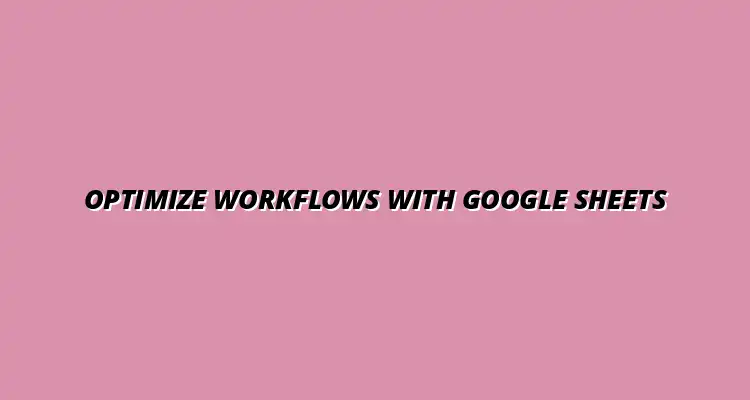
- Process Automation
- Jan 03
2025-01-01
In today’s fast-paced work environment, workflow optimization is essential for efficiency and productivity. It involves refining processes to cut down on time and resources, ultimately leading to better outcomes. One powerful tool that can aid in this process is Google Sheets templates, which help streamline various tasks. To find a wide variety of pre-built templates to jumpstart your workflow, check out this amazing resource for Google Sheets templates.
By utilizing templates, teams can standardize their approach to different tasks, making it easier to track progress and ensure consistency. These templates are designed to simplify data management, allowing users to focus on analysis rather than manual entry. This is where the real power of optimization shines!
Workflow optimization refers to the systematic approach of improving workflows to achieve better performance. It involves identifying bottlenecks, reducing redundancies, and ensuring that processes run smoothly. In a world where efficiency is critical, understanding its importance is key to organizational success. Learn more about effective data management techniques to further enhance your workflow optimization efforts by visiting this helpful guide on streamlining data management with Google Sheets.
Optimized workflows contribute to a positive work environment by reducing stress and improving team collaboration. When everyone knows their role and the tasks are clearly defined, productivity naturally increases. Here are some key reasons why workflow optimization matters:
At its core, workflow optimization is about making processes more efficient. It involves analyzing steps within a workflow and identifying where improvements can be made. This might include automating repetitive tasks, eliminating unnecessary steps, or even redesigning processes to enhance flow. For practical tips on streamlining your processes, explore these insightful articles on streamlining processes with Google Sheets.
With the right tools, such as Google Sheets templates, teams can create a structured approach to managing their work. By implementing these changes, businesses can not only save time but also reduce the risk of errors. This ultimately leads to a more productive and engaged workforce!
Optimizing workflows brings a plethora of benefits that can significantly impact a business's bottom line. By streamlining processes, companies can achieve greater output without necessarily increasing their input. Here are some notable benefits:
When these benefits are combined, they create a powerful momentum that can propel a company forward. Effective project tracking is crucial; discover how to track projects effectively in Google Sheets to maximize your workflow's potential. As workflows become more efficient, teams can redirect their focus on innovation and growth!
Google Sheets is a versatile tool that plays a crucial role in workflow optimization. It not only simplifies data organization but also enhances collaboration among team members. By using templates within Google Sheets, organizations can create a seamless flow of information. Mastering Google Sheets shortcuts can significantly boost your analytical capabilities; check out these Google Sheets shortcuts for analysis.
The flexibility of Google Sheets allows for customizations that suit various workflows, making it a go-to choice for professionals across industries. Let’s explore how Google Sheets supports workflow optimization!
One of the standout features of Google Sheets is its collaborative capabilities. Multiple users can work on a document simultaneously, which reduces the time spent on back-and-forth communication. This real-time collaboration fosters teamwork and allows for instant feedback.
Here are some collaborative features that enhance workflow optimization:
Another major advantage of using Google Sheets is its accessibility. As a cloud-based platform, teams can access their documents from anywhere, making it ideal for remote work. This means that important updates to workflows can happen instantly, no matter where collaborators are located. Discover how to further streamline tasks with Google Sheets and automation techniques.
The real-time data updates ensure that everyone is on the same page. This level of accessibility leads to better decision-making and quicker responses to any issues that arise. Overall, Google Sheets is a dynamic tool that supports organizations in their quest for efficient workflows!
Implementing Google Sheets templates can significantly improve how teams work. By customizing templates to fit specific needs, you can streamline tasks and enhance productivity. For efficient workflows using Google Sheets, refer to this helpful resource on efficient workflows with Google Sheets. Let's explore the steps you can take to create your own tailored Google Sheets templates.
Creating a customized Google Sheets template begins with understanding your workflow needs. It's important to take some time to identify what processes in your work require optimization. This might involve gathering input from team members to ensure that the template meets everyone's needs.
Once you've pinpointed the key workflow requirements, the next step is to design a user-friendly template. The goal here is to make it intuitive and easy to use, so people will actually adopt it! Consider using color coding, clear headings, and structured layouts to improve usability.
Understanding the specific needs of your workflow is crucial. Start by listing the tasks or processes that seem inefficient or cumbersome. This will help you focus on what features your template must have to be effective.
Additionally, look at previous data or feedback from team members to gauge where bottlenecks typically occur. Addressing these issues in your template design can lead to significant enhancements in your workflow.
The design of your Google Sheets template plays a critical role in its effectiveness. A user-friendly template should be visually appealing and simple to navigate. This encourages team members to engage with it rather than avoid it due to complexity.
Incorporate elements that guide users, such as instructions or examples. These can be included in a separate tab or as part of the template itself, making it easy for new users to understand how to use it.
Connecting Google Sheets with other tools can enhance its functionality and streamline your workflow. Integrating various applications can help you manage tasks more efficiently and keep everything in one place.
One effective way to achieve this is by linking Google Sheets with Google Drive and Google Workspace. This allows for easy collaboration and file sharing, ensuring that everyone has access to the latest information.
Linking Google Sheets with Google Drive can greatly enhance efficiency. It allows for seamless access to documents and saves time spent searching for files. Make sure to organize your Google Drive in a way that makes it easy to find relevant templates quickly.
Additionally, Google Workspace offers features like shared drives and calendar integration, which can improve collaboration. When templates are easily accessible and integrated with other tools, team members can work more effectively together.
Add-ons can significantly expand the capabilities of your Google Sheets templates. These tools can automate various tasks, provide more data analysis options, and integrate with other platforms. Look for add-ons that align with your team's specific workflow needs!
Some popular add-ons include project management tools, data visualization options, and automation apps. By integrating these tools, you can customize your templates even further and create a more cohesive workflow.
As you implement Google Sheets templates, you might have some questions. It's common to wonder about the best templates to use and how to select the right one for your needs. Let’s dive into some of these common queries!
Many users turn to specific templates that have proven effective for various tasks. The popularity of certain templates often comes down to their versatility and ease of use. Here are a few examples of templates that consistently receive positive feedback:
Choosing the right template is about aligning its features with your specific needs. Look for templates that are customizable and adaptable to your workflow. Consider also getting feedback from your team members on what would be most beneficial!
Absolutely! One of the great things about Google Sheets templates is their flexibility. You can modify almost any template to better fit your unique requirements. This might include adding columns, changing formulas, or even integrating your branding.
Streamlining workflows with Google Sheets templates can have a significant impact on productivity. As you implement these tools, consider how they can evolve and improve with your processes. Continuous adaptation is key to maximizing their effectiveness!
As we look to the future, cloud-based solutions like Google Sheets are becoming increasingly vital. They offer flexibility, collaboration, and accessibility that traditional tools often can’t match. Embracing these technologies will undoubtedly enhance workflow optimization across various industries.
Don't hesitate to experiment with different templates and features! This will help you discover what works best for your team. By being open to trying new ideas, you can continually improve your workflows.
Encourage your team to provide feedback on the templates you use. Gathering suggestions can lead to enhancements that benefit everyone. This collaborative approach not only improves the templates but also fosters a culture of teamwork and continuous improvement.
